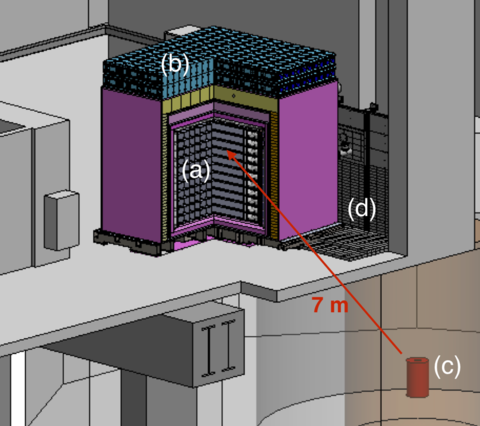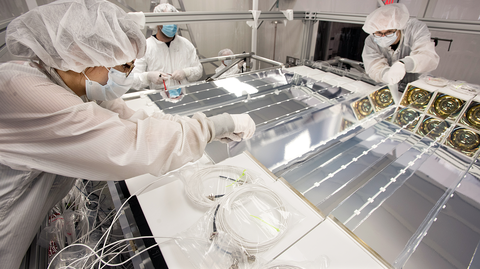Fundamental Physics: A Precision Reactor Antineutrino Oscillation and Spectrum Measurement (PROSPECT)
Summary
The Precision Reactor Oscillation and Spectrum Experiment, PROSPECT, is the first short-baseline reactor neutrino experiment in the United States since the Savannah River experiments of Reines et al. PROSPECT was conceived to address discrepancies seen in comparisons of theory and experiment in the reactor antineutrino flux and spectrum. The former motivated theoretical interest in a fundamentally new particle, a so-called sterile neutrino, and initiated a significant world-wide experimental effort. With less than one year of operation at the High Flux Isotope Reactor (HFIR) at the Oak Ridge National Laboratory, PROSPECT demonstrated the highest signal-to-background achieved in a surface detector and realized many of its physics goals, including setting new limits on the existence of eV-scale sterile neutrinos and providing the world’s most precise antineutrino energy spectrum produced by a highly-enriched 235U reactor. By successfully operating in a very challenging background environment, PROSPECT also demonstrated the technical feasibility of neutrino detectors for nuclear security purposes. The collaboration is now actively preparing for a second upgraded run of the PROSPECT experiment.
Description

The layout of the PROSPECT experiment at the HFIR research reactor at ORNL. Shown are the 11 x 14 segmented active liquid scintillator volume (a), various types of hydrogenous and high-mass shielding for background reduction (b), the very compact HFIR reactor core (c), and local lead shielding to reduce beamline gamma backgrounds.
Multiple improved global analyses of short baseline (O ~ 10-100 m) reactor antineutrino experiments carried out in 2011 suggested a significant deficit in the observed flux of antineutrinos compared to calculation. Similar anomalies had been observed in neutrino source experiments. It has been suggested that these deficits could be due to the existence of a new particle, a sterile neutrino, into which the known states oscillate making them unobservable. If this is the case, experimental verification would truly be one of the most exciting discoveries in modern physics. Alternatively, these anomalies could point to a lack of understanding in the modeling of neutrino emission from nuclear reactors and the sources in question. Interestingly, recent experimental results from active neutrino oscillation experiments like Daya Bay, Double Chooz, and Reno, have also shown that the energy distribution of antineutrinos from nuclear reactors is different than expected. PROSPECT, the Precision Reactor Oscillation and SPECTrum experiment, which has completed a first runs at the High Flux Isotope Reactor (HFIR) at ORNL was designed to measure the antineutrinos from a highly compact research reactor at a distance of less than 10 m in hopes of resolving these questions. Because of the harsh operating environment experienced by a surface-deployed neutrino experiment, the PROSPECT detector was also understood to be an important technology demonstration for potential use cases; a successful measurement of reactor antineutrinos with a detector in or near the reactor building could open new ways for nuclear safeguarding and standoff reactor monitoring.
PROSPECT was deployed at 7-10 m from the compact HFIR core. Neutrino interaction probabilities are extremely low, so the active detector consists of a segmented 4-ton 6Li-doped liquid scintillator. Antineutrinos with an energy above a threshold energy of 1.8 MeV are detected via the inverse beta-decay reaction on protons in the scintillator. The positron produced in the interaction carries most of the antineutrino energy and rapidly annihilates with an electron producing a prompt signal with energy ranging from 1 MeV to 8 MeV. Measurement of this signal can be used to determine the antineutrino energy. The neutron produced in the reaction will, after thermalizing, capture on 6Li or H with a typical capture time of 40-50 µs. Neutron captures on 6Li produce well localized mono-energetic depositions. As this capture only produces heavy charged particles, the Pulse Shape Discrimination (PSD) capabilities of the scintillator are able to separate neutron captures from gamma-ray events reducing the likelihood of random backgrounds. More importantly, the correlation in time and space between the prompt and delayed signals, both with excellent PSD discrimination, provides a distinctive antineutrino signature, greatly suppressing backgrounds. PROSPECT is unique in fully leveraging both prompt and delayed PSD. Since the scintillator provides a 5 % energy measurement of the prompt signal and the 14 cm scale detector segments are between 7-9 meters from the compact HFIR reactor core, the antineutrino interaction probability is measured as a function of both baseline and energy, enabling a highly selective search for neutrino oscillations in addition to a high-resolution spectrum measurement. These capabilities have allowed PROSPECT to achieve a and average signal to background of better than 1:1 with as high as 3:1 demonstrated in early running.

PROSPECT has recently published updated results that excluded substantial new regions of sterile neutrino oscillation parameter space. An updated analysis further extending these limits using more mature analysis is well underway. By baseline-integrating the inverse beta decay signal and performing detailed energy scale calibrations, of absolute energy response using the detector's versatile source deployment system, PROSPECT has also measured the energy spectrum of neutrinos created following fission of highly-enriched 235U HFIR core. Unlike LEU-based measurements, the PROSPECT signal therefore consists almost entirely of neutrinos from 235U fission and is unaffected by possible biases from sub-dominant fission contributions or fuel composition modelling.
NIST is playing a leadership role in the PROSPECT experiment, continuing for example, our program to develop in lithium loaded liquid scintillators with pulse shape discrimination capability. In addition, NIST has played a central role in understanding the science-driven design requirements, background simulations and shielding development, as well as characterization of reactor and cosmogenic backgrounds.
The official PROSPECT website: http://prospect.yale.edu

